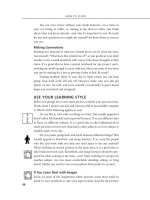Learning by Doing
Bạn đang xem bản rút gọn của tài liệu. Xem và tải ngay bản đầy đủ của tài liệu tại đây (87.7 KB, 10 trang )
31
CHAPTER
5
L
EARNING BY
D
OING
When you experience
something first-hand, you’re
a more active learner than
when you just watch or
listen to someone else’s
experience. Also, being
involved in an activity can
trigger thinking. Some
people learn better when
they’re doing something or
when a part of them is
moving; these people are
kinesthetic learners. This
chapter shows you how
active learning is important,
no matter what your
learning style. It also shows
you how to use movement
and doing to study
more effectively.
H
ow did you learn to ride a bike? To
dance? To speak? You learned by doing. Nothing can replace
the physical act of doing the thing you’re trying to learn.
Participating in a dance class forces the dancer to experience the move-
ments she is trying to learn, thereby accelerating her learning process.
Passively watching a dance recital may help her decide what kind of
expertise she wants to acquire; however, she will not become an accom-
plished dancer by simply observing.
Use It and You’ll Learn It!
Tom was not very interested in his Spanish class. Then he met Clau-
dio, a new neighbor who had recently arrived from Puerto Rico.
Claudio knew some English, but not enough to shop for groceries,
so Tom offered to take him shopping. Tom was surprised at what
he remembered from Spanish class as he explained different foods
to Claudio in the grocery store. When Claudio responded in Span-
ish, Tom was often able to figure out new words because he was
using language in a meaningful way—he was experiencing Span-
ish. It was then that Tom’s attitude toward Spanish changed. He
began to look forward to each class, because at home he was using
and learning Spanish.
HOW TO STUDY
32
Everyone needs to use techniques of active learning to some extent
to supplement their unique learning style. And if you found in Chapter
2, “Discovering How You Learn,” that you learn primarily by doing, by
kinesthetic learning, you need to see how you can maximize this style in
your studying.
BECOMING AN ACTIVE LEARNER
When you’re an active learner, you feel more in control of your studying.
You’re actively using your questions, your answers, your images, your
order. You’re noting what’s important to you. You’ll find you want to
study when you’re making these decisions for yourself. Assume
responsibility for your own learning, and learning will become enjoyable.
One way to be an active learner is to think ahead before you read
something.
Right now, write the answers to these questions in your notebook,
or speak them into your tape recorder.
• What are you expecting to happen in this chapter?
• What questions do you have about this chapter?
Try It!
LEARNING BY DOING
33
P
LAY THE
P
ART
Y
OU
W
ANT TO
B
E
One way to be an active learner is to act the part of a learner. By doing so,
you will feel more in control of your studying. Here are a few ways you
can role play and become an active learner:
• Pretend you’re the instructor. Decide what you want the class (you)
to focus on.
• Choose a character from the material you’re studying, and
pretend you are that character. If there’s dialogue in the text, this is
an especially effective exercise. If you’re listening to a tape of a
speech, pretend you’re the speaker. What part of your speech did
you like best? If you’re reading a biography, take the part of that
person and try to imagine what it would be like to live that life.
• Create a character. Perhaps you’re studying a text without any
characters—biology, for example. You could be a laboratory
technician, comparing cell samples. Or an anthropologist, prepar-
ing to study animals in their natural habitat. Or an ecologist,
studying native fauna or flora to reconstruct a preserved wood-
lands. The possibilities are endless.
• Talk to yourself as you imagine the character would, based on what
you remember from the tape or reading.
• If you’re working with a study buddy, you can each be a different
character, and discuss—or argue about!—the topic you’re study-
ing. (You may want to skip ahead to Chapter 16, “Working with a
Study Buddy,” for some ideas.)
W
ATCHING
C
AN
B
E
L
IKE
D
OING
Think of a time when you were watching a sports event. Maybe it was a
football or baseball game, or a hockey match. How did you get involved
in that game? Maybe you jumped up when a certain play was made. Why?
Did you shout out? Did you feel your stomach tighten or your heart
pound at a suspenseful moment? Even though you were a spectator,
watching someone else’s experience, you were still experiencing the game.
And you can do that in studying.
Move Around to Refresh and Re-focus
Larry was so nervous about a civil service test coming up that his
brain would freeze whenever he tried to study. He would open his
book, and although he knew what the words meant, he just
couldn’t put them together. He sat there trying to study, but noth-
ing seemed to make sense. All the while, he was thinking of how
important the test was and how he had to get a good grade. In
frustration, he got up and went for a walk for half an hour. Then
a strange thing happened. The more he walked, the clearer his
head felt. After awhile, he found himself thinking about what he
had been trying to study. When he returned to his book, the
words made sense for the first time.
HOW TO STUDY
34
M
AKE
T
HINGS
H
APPEN
When you are learning certain skills, it helps to be in the actual place
you’d use those skills, like a lab, a police station, a nursery school, or a
health clinic. But this isn’t always possible. For instance, if you
were learning to fly a plane, you’d first spend time in a simulator, a
computerized cockpit on the ground that simulates flying. Another
option is to use your imagination to visualize yourself in an actual
situation, in an actual place. Involve yourself with the material by asking
your own questions, in addition to any assigned questions, and then
finding your own answers. You become an active learner when you create
your own experience.
SUGGESTIONS FOR KINESTHETIC LEARNERS
If using your body or hands is the primary way you learn, there are
several ways you can make the most of your learning style.
W
ALK AS
Y
OU
R
EAD OR
W
RITE
Whether outside on a warm day or through the hallways of your home
or library, you’ll find this technique a good way to make sense of difficult
reading or to overcome writer’s block. If doing is your style, you may find
ideas just popping into your head as you walk!
LEARNING BY DOING
35
U
SE A
C
OMPUTER
If you don’t own a computer, ask around at school, work, or the local
library for one you can use. You’ll find it’s almost like having a study
buddy. There’s constant action involved when using a computer. Your
hands are moving back and forth on the keyboard and, if you have a
mouse, you’re pushing it around the mouse pad. The screen, too, is always
in motion. The cursor skips across the window; words and images scroll
up and down. The quick response on the screen as you push a key or click
a mouse button can make studying a more stimulating experience.
It can make studying a more magical experience, too. Press a button
on the keyboard and you have a file cabinet, fancy typewriter, calculator,
secretary, post office, and library.
If English is your second language, use a larger-size type font, and
double- or triple-space whatever you’re working on. It’s easier to recog-
nize a foreign language, especially a foreign alphabet, if it’s set larger. If
you’re turning in a paper at school or work, you may need to reduce the
size of the font—but keep the larger size for yourself. Remember, too, to
read out loud (even if you’re a visual learner!) to check if what you’ve
written sounds like standard English.
New to the computer?
There are folks who can introduce you. If you’re about to use a computer
at school or work, trained staff are generally available to help you. If you
bought a home computer, chances are that the manual that came with it
has a phone number to call if you have questions.
• If the computer in general is making you nervous, try making it
friendlier, more familiar. Put something you like on or near it. (As
long as it’s not edible! If food or drink seeps into the computer, it
can interfere with what the computer is trying to do.) Maybe you
have a favorite postcard or photograph. Maybe you have an
unbreakable miniature figure or statue of a favorite animal, a
totem, or icon. You choose! The idea is to help make the unfamil-
iar familiar.
• If it’s typing on the computer, facing that blank screen, that gives
you the heebee-jeebies, turn the monitor light down. (The dial is
usually under the monitor. It may have symbols such as a sun at
ESL









